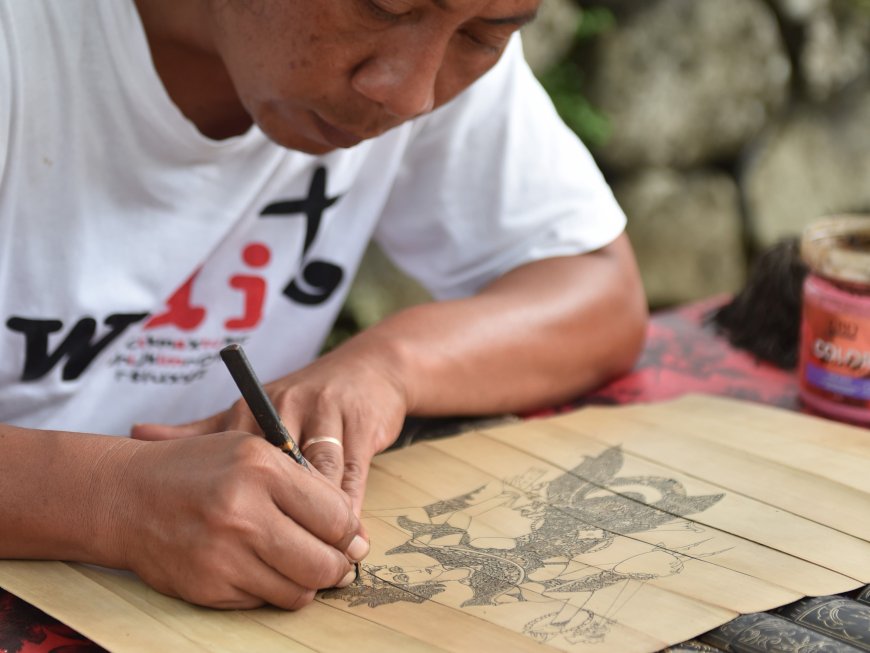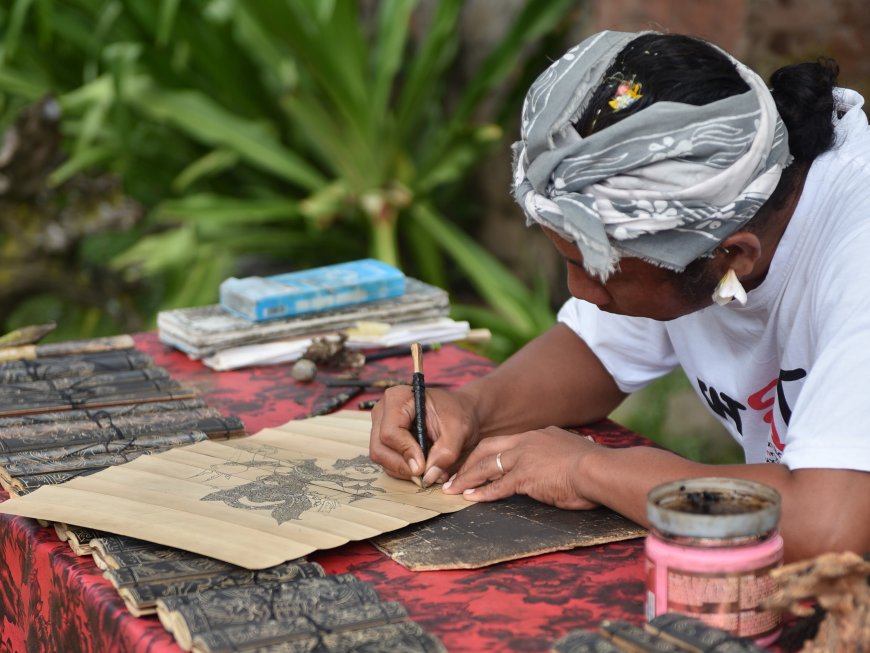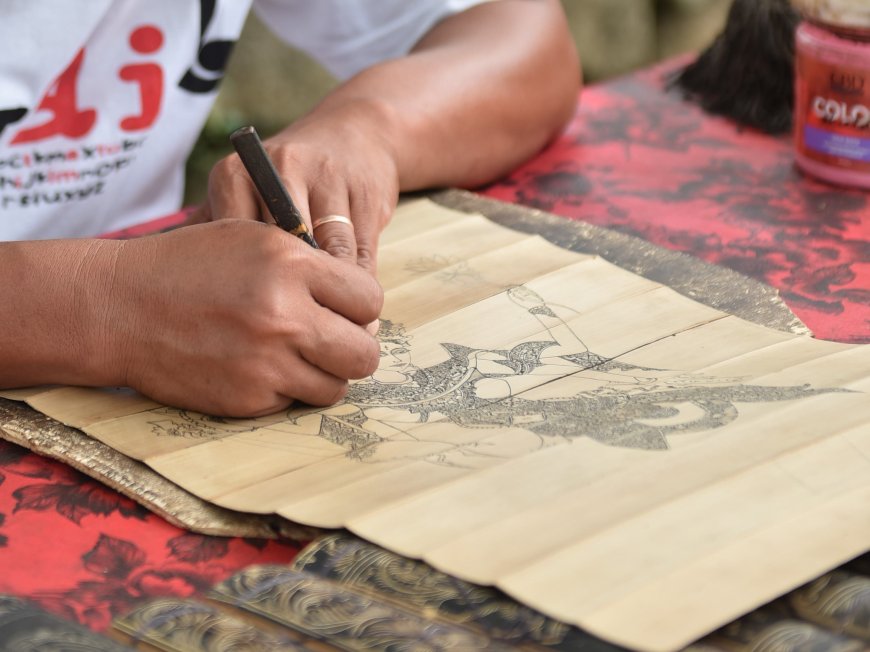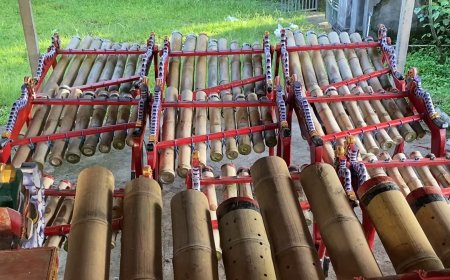Weaving Traditions, Sustainable Art
The island of Bali is also known for its traditional art of writing, known as the art of "lontar" or nyurat lontar. Nyurat lontar is the tradition of writing on lontar leaves and is a unique and important writing art in Balinese culture. The lontar tradition in Bali has a long historical journey and old age along with the values of history, religion, philosophy, medicine, literature, and other high sciences.

The island of Bali, often referred to as the "Island of the Gods," is not only a famous tropical tourist destination, but also a place where art and culture thrive. Nestled among the exotic Indonesian islands, Bali offers more than just beautiful beaches and stunning natural scenery. The island is also home to a very rich artistic heritage, which reflects the beauty, majesty, and deep spirituality that has been rooted in Balinese society for centuries. Art in Bali is not just entertainment or an ordinary form of artistic expression. Art itself is part of the daily lives of its people, becoming a language that connects them to their ancestral heritage and deep spiritual beliefs. In mesmerizing dances, awe-inspiring sculptures, creative paintings, enchanting music and mesmerizing scriptures, Bali presents an unparalleled art experience to its visitors.
The island of Bali is also known for its traditional art of writing, known as the art of "lontar" or nyurat lontar. Nyurat lontar is the tradition of writing on lontar leaves and is a unique and important writing art in Balinese culture. The name "lontar" refers to the lontar leaf, which is the traditional medium for writing in Bali. Lontar leaves are taken from the lontar trees that grow abundantly on the island. The art of lontar is a precious cultural heritage that has existed for centuries. Nyurat lontar has been recognized as a world cultural heritage. Despite its age, this tradition is not only practiced by older Balinese, but also by younger generations. According to the paper Lontar Bali compiled by Dr. Drs. Ida Bagus Rai Putra, M.Hum, the word lontar describes the medium or basic material for composing nyurat lontar, which is ental leaf, a type of palm leaf. The lontar tradition in Bali has a long history and old age along with the values of history, religion, philosophy, medicine, literature, and other higher sciences. Lontar is a recorder of the universe of thought of the people in Bali until in its current form it is a witness to history and a historical cross-section of literacy and civilization with character. Balinese lontar manuscripts in the history of Balinese civilization show the progress and inner intelligence of the Balinese people.
The lontar tradition in Bali has a long history and old age along with other high values of history, religion, philosophy, medicine, literature, and science. Lontar is usually used to write down Hindu classical texts, such as the Ramayana and Mahabharata stories, religious texts and Balinese literature. In addition, lontar art is not only in the form of writing, but can also be in the form of drawings of important figures in the Hindu faith in Bali. The process of writing lontar is very complicated, where a poet or author must manually carve letters, symbols or draw on lontar leaves using a special tool called "pangrupak" or a writing knife. In addition to pangrupak, the tools used during nyurat lontar are pepesan (tal leaves that are ready to be written on), pelican (bamboo leaf clamp made of small bamboo), tingkih powder (from roasted candlenut fruit) or naga sari fruit powder, wooden dulang as a writing table and a small mattress pad as a base, panakep made of wood or bamboo, cotton or fine cloth to erase blackening material, kropak chest to store the final result and offerings.

People Making Prasi Dewi Saraswati (Photo Source: Private Collection)
Lontar is also central to the oral tradition in Bali, where poets often memorize the texts and recite them in oral literary performances. This is a way for the Balinese to preserve their knowledge, classic stories, and culture orally from generation to generation.
For the Balinese people, lontar is not just a tradition and a cultural product. Lontar is also historical evidence of Balinese civilization amidst the rapid development and civilization of the world. The lontar contains important knowledge for Hindus such as the implementation or procession of ceremonies, behavioral guidelines for saints, traditional medicine procedures, cooking spices and others. Some types of lontar are such as:
Lontar Sundarigama
Lontar Sundarigama contains procedures for the implementation of Hindu ceremonies. This lontar is the word of Bhatara Guru or Lord Shiva to the priests who advised the king. Sundarigama comes from the word sunar which means bright light or sesuluh, ri which means siddi or perfection, and gama is religion or life guidance. So Lontar Sundarigama means a holy book that provides light or sesuluh as a guide for the implementation of Hindu ceremonies or rituals, especially in Bali. This lontar manuscript mentions explanations related to holy days such as Purnama Day, Tilem, Nyepi, Tumpek Landep, Saraswati, and others. It also explains the processions and ceremonial tools used on these holy days.
Lontar Bebaretan Wong Beling
The Lontar Beberatan Wong Beling is about how to have children who are suputra or devoted to parents and family. It contains moral messages addressed to pregnant husbands and wives. There are several important points in this lontar text, namely, ethics and self-control for the family and husband of the pregnant wife, ethics and self-control for the pregnant mother, ceremonies that should be carried out when the mother is pregnant, treatment for the pregnant mother and the ceremonial procession after the baby is born.
Lontar Sangkul Putih and Lingganing Kusuma Dewa
Lontar Sangkul Putih and Lingganing Kusuma Dewa contain the procedures and gagelaran of a pemangku in carrying out the ceremonial procession. The sequence or dudonan of works is explained in great detail and systematically in these lontar. It is intended that the pemangku in carrying out swadharma (obligations) carry out the ceremony procession properly. This lontar also contains mantras that are used as a guide for the pemangku.
Lontar Roga Sanghara Bumi
This Lontar manuscript contains Hindu disaster mitigation knowledge. Roga Sanghara Bhumi comes from the word roga which means disease, illness, and disability. Sanghara or samhara means damage, dissolution, negation, and destruction. Bhumi means earth, so this lontar means to negate or neutralize disasters in the world by performing certain ceremonies. This lontar discusses disasters and natural signs that occur.
Lontar Bharma Ketih
Lontar Bhama Kertih discusses the guidelines in building a house or yard as a place to live. This includes explaining the characteristics of yards that have positive and negative auras or often referred to as karang panes and how to overcome them. This Lontar also explains how to build a traditional Balinese house. In addition to the yard, Lontar Bhama Kertih reviews the ceremonies that must be performed when starting to build a house or yard.
Lontar Usadha Buduh
As the name implies, buduh is Balinese for crazy, while usadha means traditional medicine. So Lontar Usadha Buduh contains knowledge about madness and how to treat it. The treatment is based on the characteristics of madness experienced by a person. There are several types of insanity described in this lontar. The treatment is also done without looking at the characteristics of madness, or it can be said to be the treatment of madness in general.

People Making Prasi (Photo Source: Private Collection)
In addition to writing manuscripts on palm leaves, there is also a special Balinese traditional art that is not known by many people, namely drawing on palm leaves called prasi. Prasi painting is painting on palm leaves with a "pangrupak" or a special Balinese knife. The art of prasi itself does seem simple with classic Balinese patterns, but if you look more carefully, prasi has a complex and magical style. Quoting from the website of the Ministry of Tourism and Creative Economy (Kemenparekraf), the art of prasi painting is a legacy of the art of the Balinese Royal era. It is characterized by the presence of ancient Balinese letters or Balinese literature on the palm leaves as the painting medium.

People Making Prasi Dewi Saraswati (Photo Source: Private Collection)
Prasi paintings are in great demand among tourists, especially foreign tourists. Usually, prasi paintings are used as wall hangings or decorations at home. This painting made by scratching is truly unique because it has a symbolic meaning of a story that the painter wants to convey. The art of prasi is known to have developed since Hinduism began to enter the lives of Balinese people. Initially, lontar prasi was a sacred medium, with the development of the times, this art fulfilled aesthetic, and economic needs, then developed into an art industry business.





























































